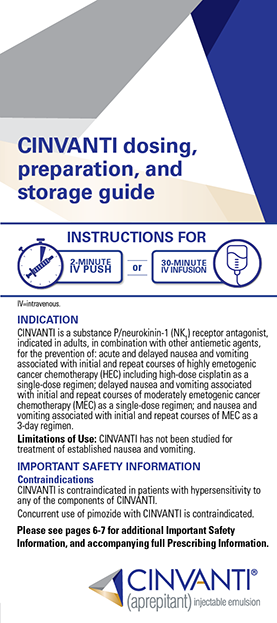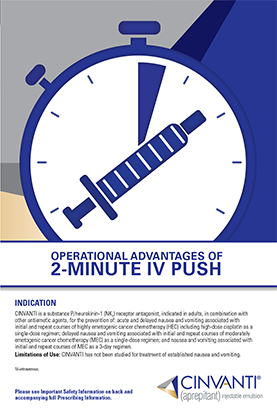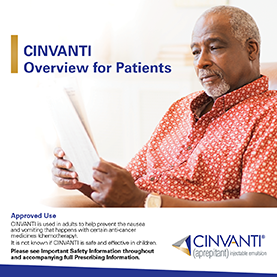Indication
CINVANTI is a substance P/neurokinin-1 (NK1) receptor antagonist, indicated in adults, in combination with other antiemetic agents, for the prevention of: acute and delayed nausea and vomiting associated with initial and repeat courses of highly emetogenic cancer chemotherapy (HEC) including high-dose cisplatin as a single-dose regimen; delayed nausea and vomiting associated with initial and repeat courses of moderately emetogenic cancer chemotherapy (MEC) as a single-dose regimen; and nausea and vomiting associated with initial and repeat courses of MEC as a 3-day regimen.
Limitations of Use: CINVANTI has not been studied for treatment of established nausea and vomiting.
Important Safety Information
Contraindications
CINVANTI is contraindicated in patients with hypersensitivity to any of the components of CINVANTI.
Concurrent use of pimozide with CINVANTI is contraindicated.
Warnings and Precautions
Clinically Significant CYP3A4 Drug Interactions
Aprepitant is a substrate, weak-to-moderate (dose-dependent) inhibitor, and an inducer of CYP3A4.
- Use of CINVANTI with other drugs that are CYP3A4 substrates may result in increased plasma concentration of the
concomitant drug.
- Use of pimozide with CINVANTI is contraindicated due to the risk of significantly increased plasma
concentrations of pimozide, potentially resulting in prolongation of the QT interval, a known adverse reaction of pimozide.
- Use of CINVANTI with strong or moderate CYP3A4 inhibitors (e.g., ketoconazole, diltiazem) may increase plasma concentrations of aprepitant and result in an increased risk of adverse reactions related to CINVANTI.
- Use of CINVANTI with strong CYP3A4 inducers (e.g., rifampin) may result in a reduction in aprepitant plasma concentrations and decreased efficacy of CINVANTI.
Hypersensitivity Reactions
Serious hypersensitivity reactions, including anaphylaxis, during or soon after administration of CINVANTI have occurred. Symptoms including dyspnea, eye swelling, flushing, pruritus, and wheezing have been reported. If hypersensitivity reactions occur, discontinue CINVANTI. Do not reinitiate CINVANTI in patients who experience these symptoms with previous use.
Decrease in INR with Concomitant Warfarin
Co-administration of CINVANTI with warfarin, a CYP2C9 substrate, may result in a clinically significant decrease in the International Normalized Ratio (INR) of prothrombin time. Monitor the INR in patients on chronic warfarin therapy in the 2-week period, particularly at 7 to 10 days, following initiation of CINVANTI with each chemotherapy cycle.
Risk of Reduced Efficacy of Hormonal Contraceptives
The efficacy of hormonal contraceptives may be reduced during administration of and for 28 days following the last dose of CINVANTI. Advise patients to use effective alternative or back-up methods of non-hormonal contraception during treatment with CINVANTI and for 1 month following administration of CINVANTI or oral aprepitant, whichever is administered last.
Use in Specific Populations
Avoid use of CINVANTI in pregnant women as alcohol is an inactive ingredient for CINVANTI. There is no safe level of alcohol exposure in pregnancy.
Adverse Reactions
The most common adverse reactions are:
- Single-dose fosaprepitant with MEC (≥2%): fatigue, diarrhea, neutropenia, asthenia, anemia, peripheral neuropathy, leukopenia, dyspepsia, urinary tract infection, pain in extremity.
- 3-day oral aprepitant with MEC (≥1% and greater than standard therapy): fatigue and eructation.
- Single-dose fosaprepitant with HEC: generally similar to 3-day oral aprepitant. In addition, infusion site reactions (3%) occurred.
- Single-dose CINVANTI (≥2%): headache and fatigue. The safety profile of CINVANTI in healthy subjects who received a single 2-minute injection was similar to that seen with a 30-minute infusion.
Report side effects to the FDA at 1-800-FDA-1088 or www.fda.gov/medwatch. Report side effects to Heron at 1-844-437-6611.



